Brief

Note to readers
Welcome to the fifth annual report on the global diamond industry prepared by the Antwerp World Diamond Centre (AWDC) and Bain & Company.
In this year’s edition, we take a comprehensive look at the year’s major developments along the diamond value chain. We focus on the reasons for the recent drop in rough and polished prices against the background of continued but slowing growth in the macro economy.
As in previous years, we start with key developments along the value chain and a review of recent economic fundamentals that are the long-term drivers of diamond jewelry demand and prices.
We look at the long- and short-term factors influencing prices to better understand the recent declines in polished and rough-diamond prices and expectations for their recovery. We compare 2014 results with the results of previous years and review the market to date in 2015, which has been marked by demand uncertainty and price declines.
We also provide an update on the long-term outlook for the diamond industry through 2030. The 2030 supply-demand outlook is based on long-term macro-fundamental factors and incorporates the effects of the recent decline in demand from China.
Readers looking for a quick overview of the main messages and key takeaways of this report can find them below:
- In 2014 and the first half of 2015, revenue across the diamond industry value chain grew by 4% to 8% as demand has slowed in China while continuing to grow in the US. Despite a generally solid performance in 2014, the second half of that year and the first half of 2015 have been characterized by a degree of uncertainty in the diamond industry. The primary source of this uncertainty is China’s slowing GDP growth, which we highlighted as a potential risk in a previous edition of this report. Greater China’s diamond jewelry retail dynamics caused a decrease in demand for polished diamonds and, in turn, rough diamonds. In addition, the jewelry consumption spike in the Chinese market in 2013 led to inflated expectations of further growth in demand for diamond jewelry that were not realized. These expectations led to stock accumulation throughout the diamond pipeline, causing price declines for both polished and rough diamonds.
- The Greater China diamond jewelry market appears to be in turbulence in the short term. By now, the three largest retailers have posted significant year-over-year drops in diamond jewelry sales driven by the stock market crash and continued consumer uncertainty.
- In 2015, the diamond industry suffered the ripple effect from the mild decline in consumer demand for diamond jewelry that started in 2014 in Greater China. That slowdown led to a notable drop in demand for polished and rough diamonds, which in turn led to price decreases for polished and rough diamonds of 12% and 23%, respectively, since May 2014 and of 8% and 15%, respectively, since the beginning of 2015. The weaker-than-expected growth in customer demand initially affected demand for polished diamonds as retailers built up inventories and reduced purchases of polished diamonds. The slowdown then extended to rough-diamond producers as mid-market companies built up their inventories and reduced their purchases of rough diamonds despite declining prices.
- We believe that regular circulation of diamonds through the pipeline should be restored as soon as the midmarket and retail segments clear their excess inventories. This time, however, the market should return to its long-term growth trajectory more quickly than is the historical norm because of positive macroeconomic fundamentals. Conscious management of supply levels by rough-diamond producers and polished-diamond manufacturers, however, is necessary for a sustained recovery.
- Amid industry turbulence and continuing pressure on the market, mid-market companies are being forced to reevaluate their business models. At the moment, the segment is not robust enough to cushion against short-term fluctuations in the diamond jewelry retail market. The mid-market has little bargaining power over rough producers and retailers and limited access to financing, yet mid-market players unconsciously or deliberately bear risks and benefits of price volatility that their business models cannot support. We observe that the continuing development of the mid-market segment should enable the industry to implement more sustainable business models.
- As in past years, the industry faces key challenges: sustaining long-term demand for diamonds in developed markets and among a new generation of consumers, and boosting demand from other sources than jewelry and aesthetic use. The risk of penetration of undisclosed synthetic diamonds persists; there is, however, no reason to believe that it will have any considerable impact on the market in the near future. One of the key industry priorities in 2016 for restoring a sustainable, healthy diamond pipeline will be to restore the midmarket segment’s profitability, which declined in 2014 and 2015 because of deteriorating demand for polished diamonds and excess inventories in the middle segment.
- The long-term outlook for the diamond market remains positive, with demand expected to outpace supply starting in 2019. Until then, the rough-diamond supply-demand balance will be tight. We expect demand for rough diamonds to recover from the recent downturn and return to a long-term growth trajectory of about 3% to 4% per year on average, relying on strong fundamentals in the US and the continued growth of the middle class in India and China. The supply of rough diamonds in value terms is expected to decline by 1% to 2% per year through 2030.
1. Recent developments in the diamond industry
- The year 2014 was another growth year for the diamond industry. However, softening demand for diamond jewelry in the second half of 2014 translated to slower growth in the mid-market and retail segments.
- Softening retail demand continued into 2015, making its way down the value chain, which led to falling prices and decreased rough-diamond sales.
- Cutters and polishers posted revenue growth in the mid-single digits in 2014, driven by low-cost players in India and China amid continued multiyear decline in profitability.
- Retail sales of diamond jewelry grew 4% in 2014 as solid US sales offset the slowdown in China. The results of 2015 to date indicate that the US market continues to grow while the Chinese market continues to slow.
- Despite the growth of the overall market, prices of polished and rough diamonds have fallen 12% and 23%, respectively, since May 2014 and 8% and 15%, respectively, since the beginning of 2015, as short- and long-term factors have shaped price dynamics.
- The short-term story of 2014 and 2015 centers on the buildup of stocks throughout the diamond pipeline. In the second half of 2014, consumer demand for diamond jewelry from Greater China was weaker than expected, which led retailers there to trim orders for polished diamonds and, in turn, to falling demand for polished diamonds and inventory buildup in the cutting and polishing (C&P) segment. Scarcer financing for the mid-market segment compelled the most troubled players to unload inventory at lower prices, further pushing down the prices of polished stones. By the second half of 2014, major producers were reducing rough pricing in reaction to weaker demand from the middle market.
- In the long term, both polished and rough prices are driven by macroeconomic fundamentals that remain positive. Prices took 18 to 24 months to rebound after the previous economic turmoil of 2001 and 2009. The current situation, featuring positive macroeconomic factors, is decidedly different. Prices are likely to recover faster this time as accumulated stocks are worked down, assuming conscious management of production levels by rough-diamond producers and polished-diamond manufacturers as well as continued consumer demand.
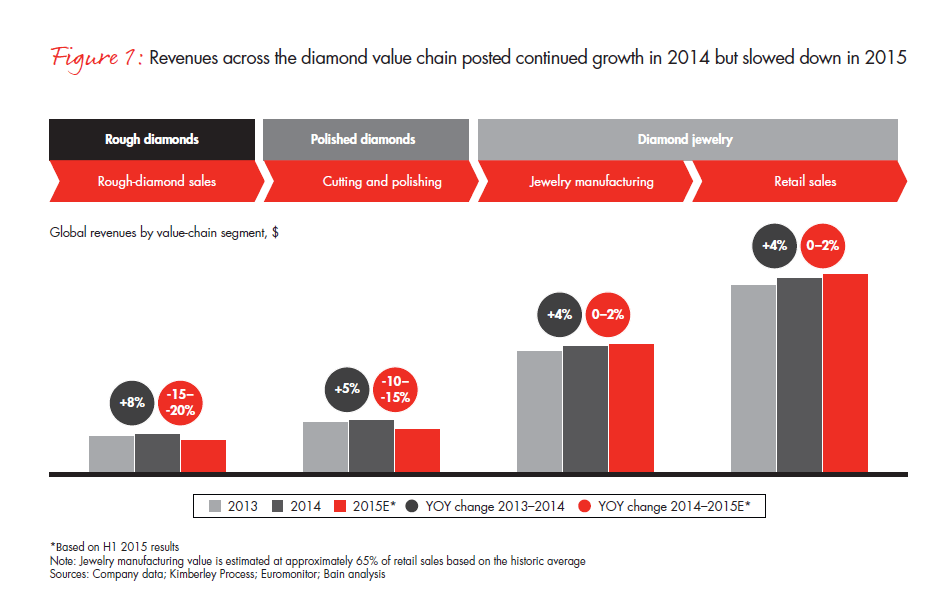
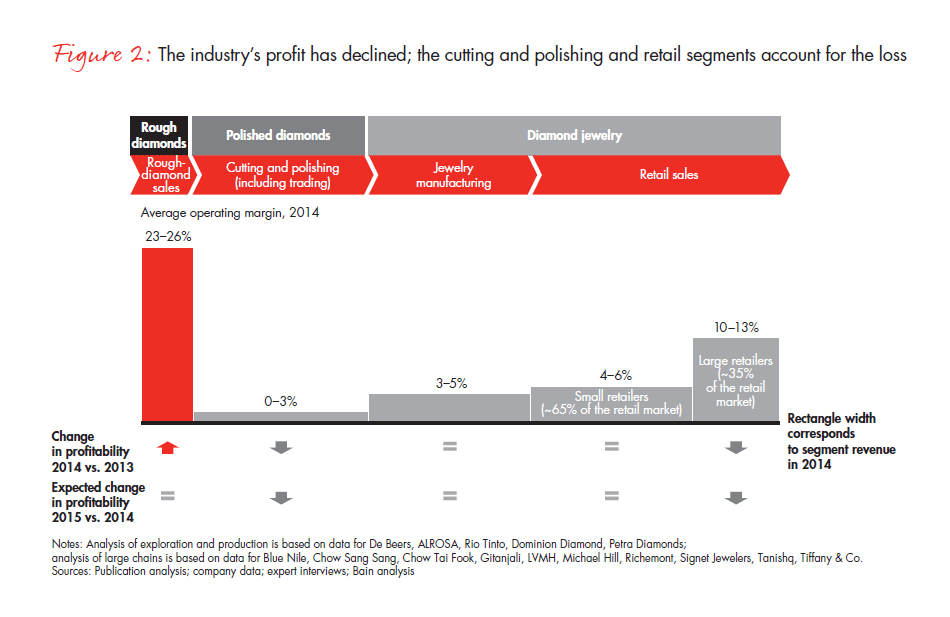
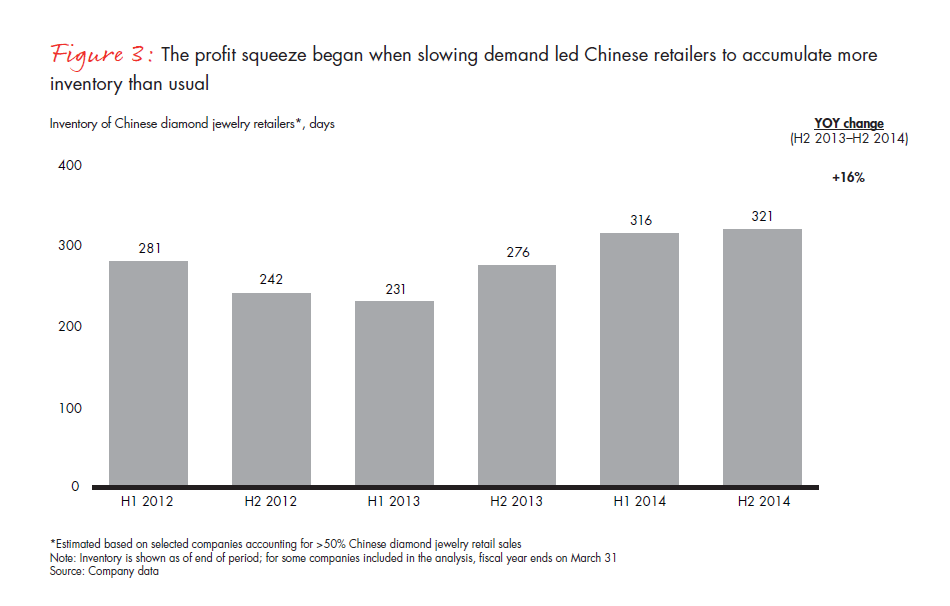
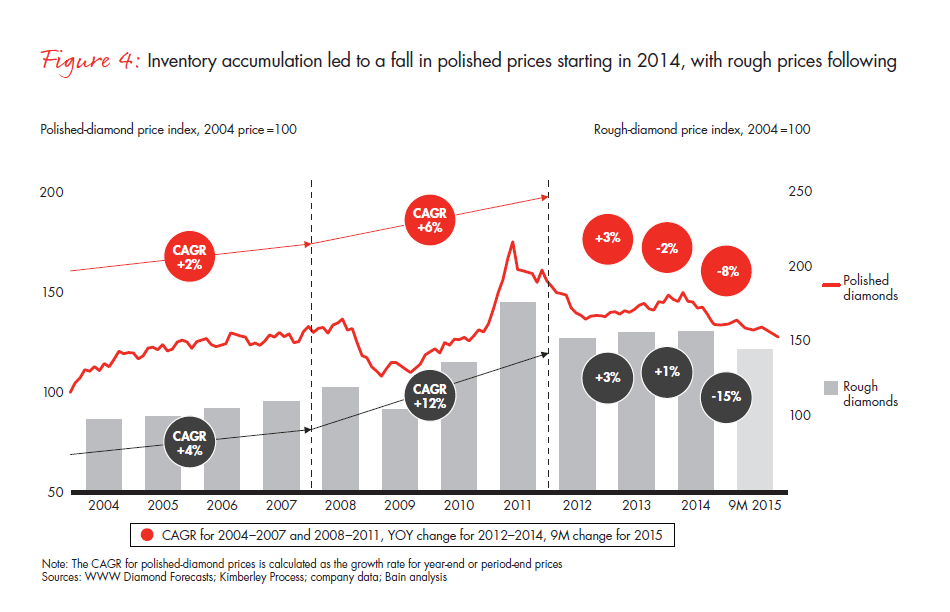
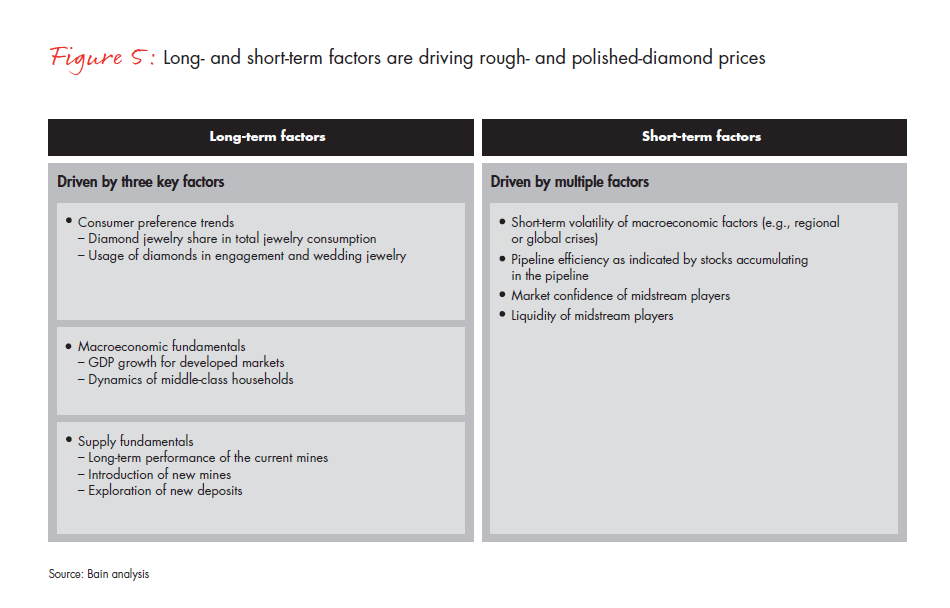
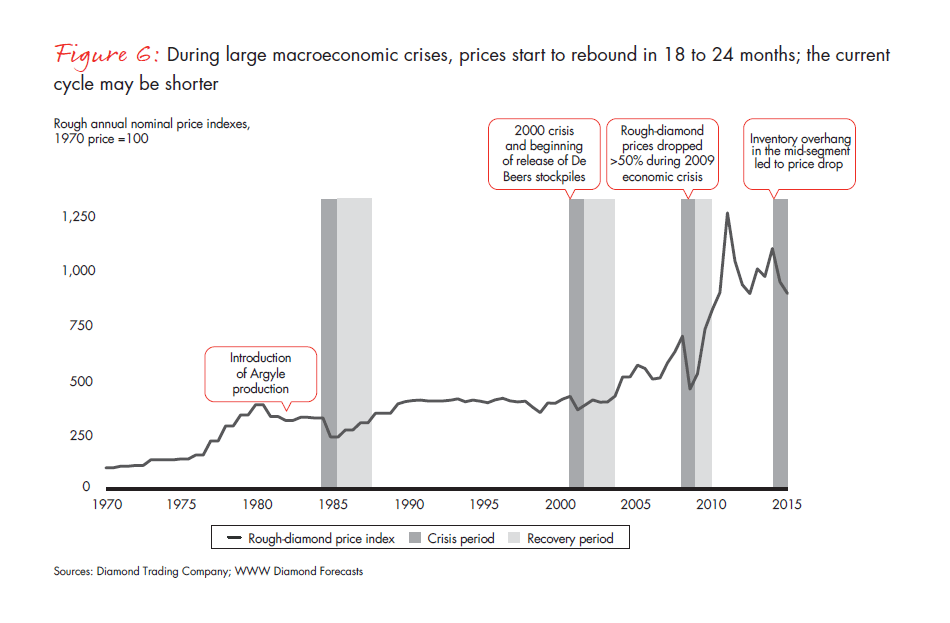
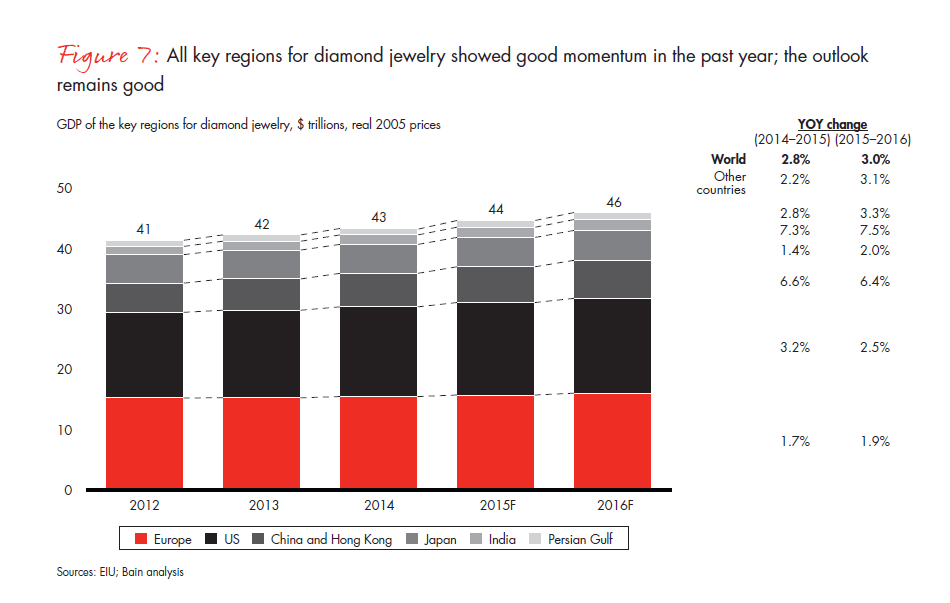
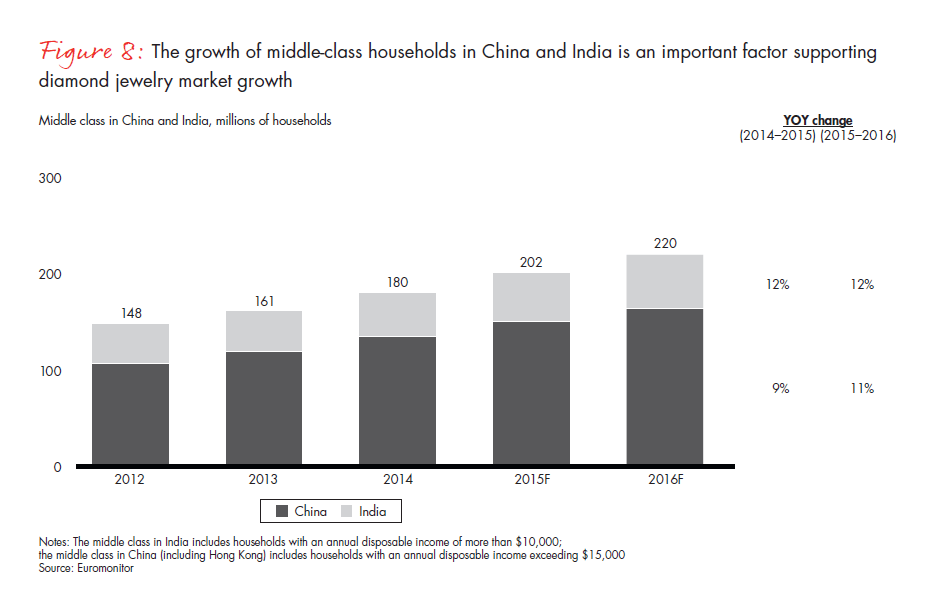
2. Rough-diamond production
- Rough-diamond revenues grew 8% in 2014 on the strength of increased sales by the top five producers and despite a decline in the overall volume of carats mined. De Beers, ALROSA and Dominion Diamond accounted for about 90% of the more than $1.2 billion in incremental global sales of rough diamonds.
- Rough-diamond production volume fell by 4% globally in 2014 to slightly less than 125 million carats. The largest drops occurred in Australia and Africa. Botswana’s continued production growth was not sufficient to offset a major drop in production from Zimbabwe caused by deterioration of its existing alluvial deposits and lack of investments and expertise to enable deeper mining operations.
- First-half production in 2015 grew by 7% over the first half of 2014, largely because of increased production by ALROSA and Rio Tinto. Rough prices fell significantly in the first half of 2015, while year-over-year sales for most of the top five dropped 21% to 27% for different companies.
- The top five producers accounted for more than 70% of global production by volume—roughly matching the group’s pre-crisis market share as a group. The natural volatility of mining operations accounts for most of the change in various producers’ production volumes. The top five resumed production growth in the first half of 2015, increasing output by 8% compared with the first half of 2014.
- Margins on earnings before interest and taxes (EBIT) were mixed in the first half of 2015. The largest companies managed to sustain or even increase profitability despite declining revenues.
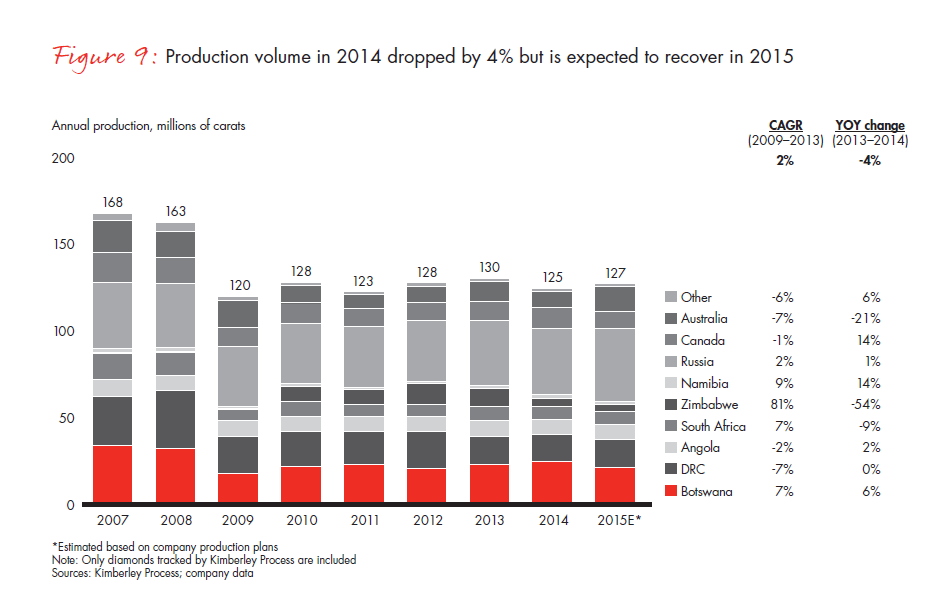
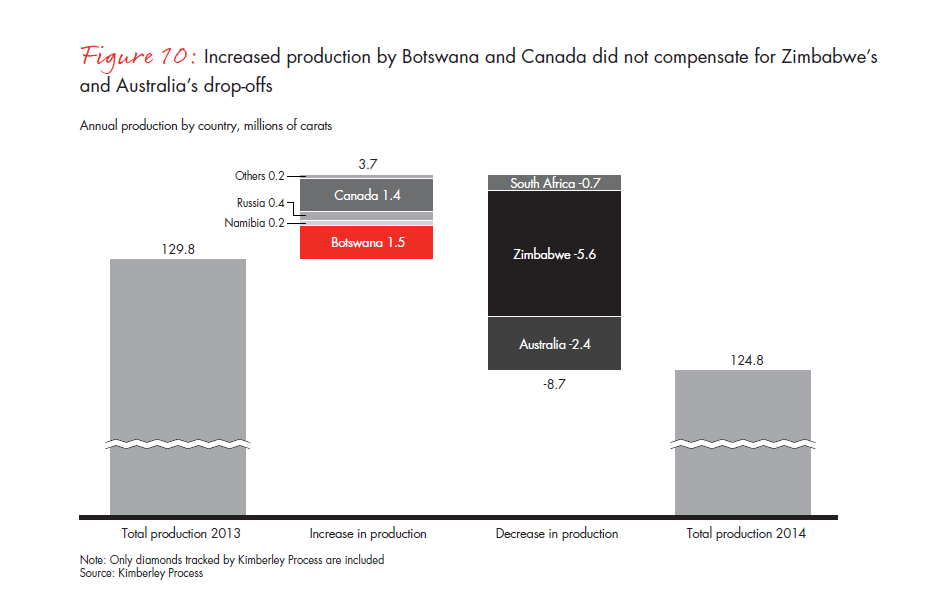
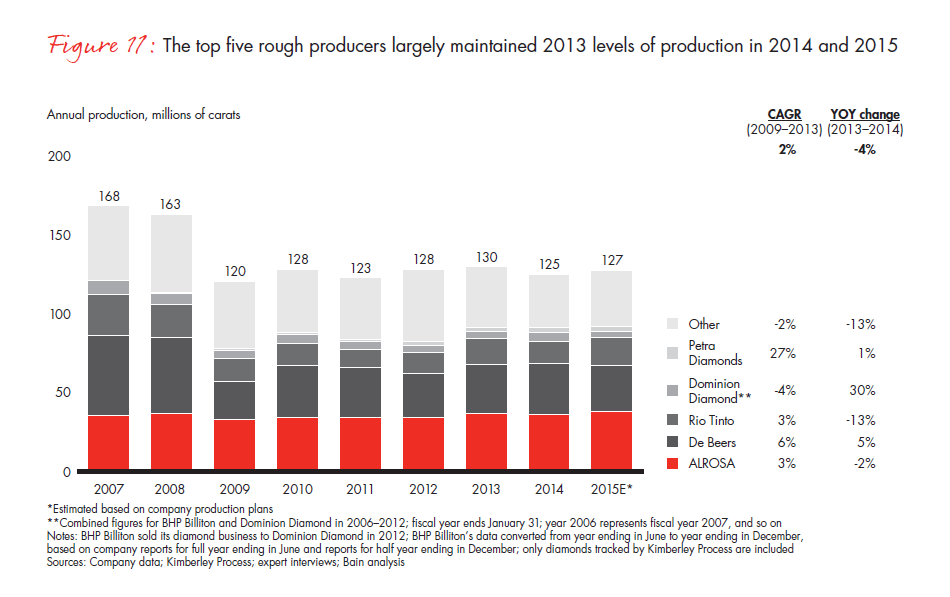
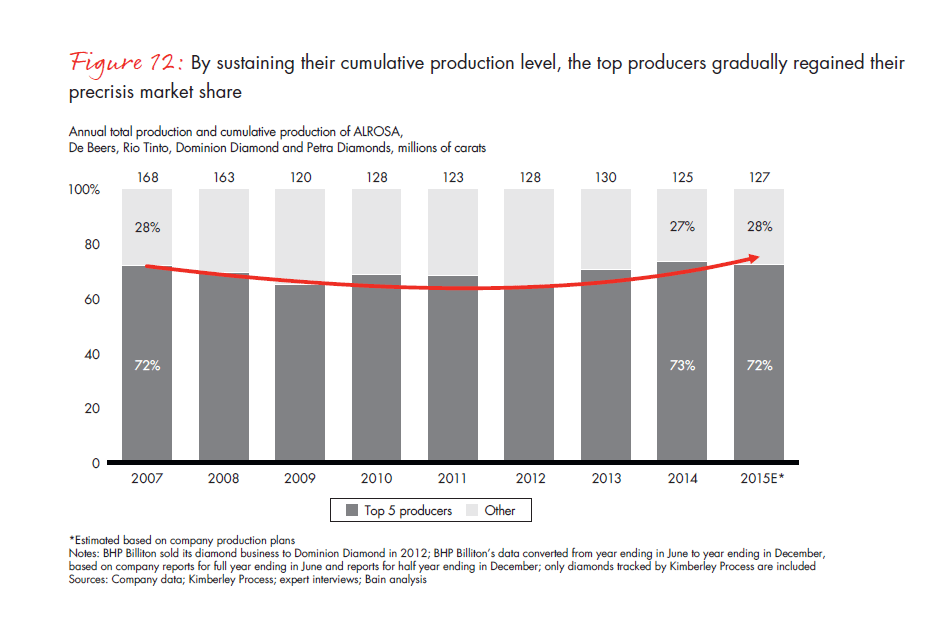
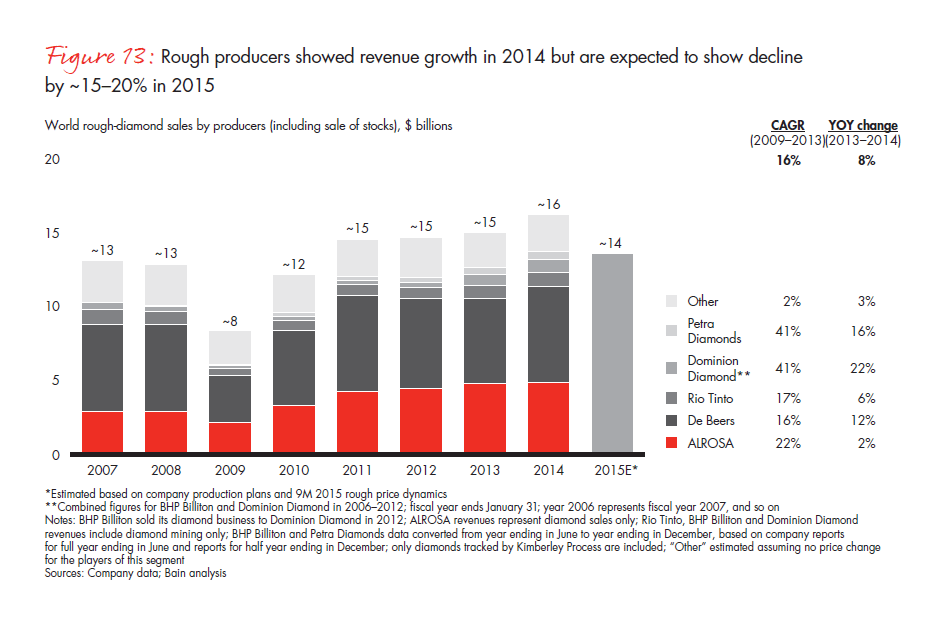
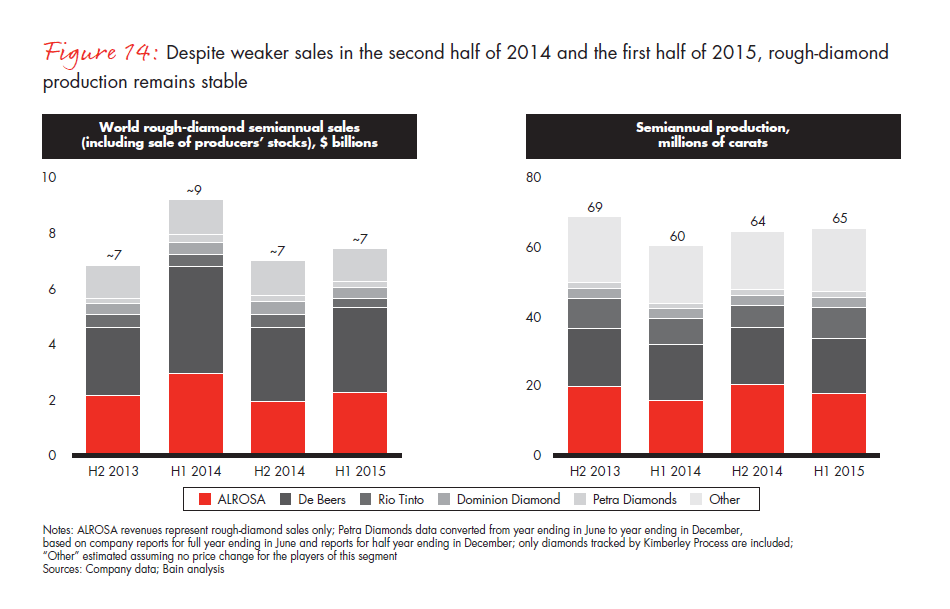
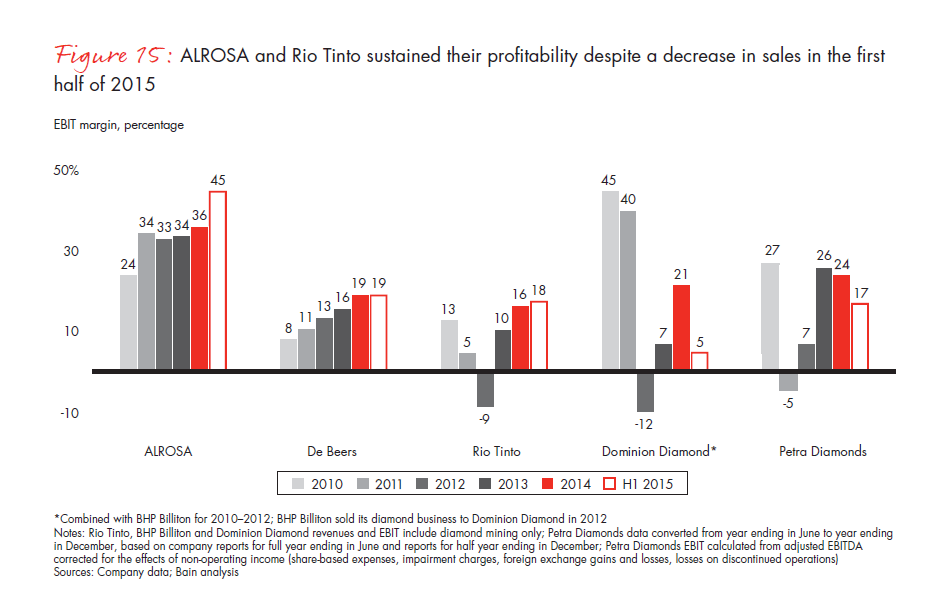
3. Cutting and polishing
- The C&P market continued its positive trajectory in 2014 with growth in the mid-single digits.
- India and China, the most cost-efficient countries, both gained market share in value terms. Their combined market share of the global market now stands at around 85%.
- The high-cost centers of Belgium, Israel and the US, which focus on high-end stones, recorded declines in polished revenue as volumes of large stones migrated to India. India now cuts and polishes more than 40% of diamonds larger than 1 carat, with quality standards comparable to those of developed markets.
- Africa’s C&P market declined dramatically in 2014 despite beneficiation efforts by the governments of Botswana, Namibia and South Africa. These countries have not become competitive in terms of manufacturing efficiency and skilled labor.
- In 2015, C&P activity slowed significantly because of accumulated diamond jewelry stocks and reduced demand for polished diamonds. The average operating margin in the segment has deteriorated further, to close to zero. Some players posted operating losses of 5% or more in 2015.
- Most companies that sustained margins pursued one of two models: specialization in particular types of stones while working on consignment, or integration with the diamond jewelry retail segment.
- The industry’s leverage is expected to decrease from $16 billion in 2013 to approximately $13 billion by 2016.
- Lower margins are driving weaker C&P players out of business, while more efficient manufacturers accept higher rough prices to neutralize competition. The coming years may see significant consolidation and operational efficiencies. This is a positive development for the industry as it may develop a more attractive risk profile and more efficient diamond pipeline.
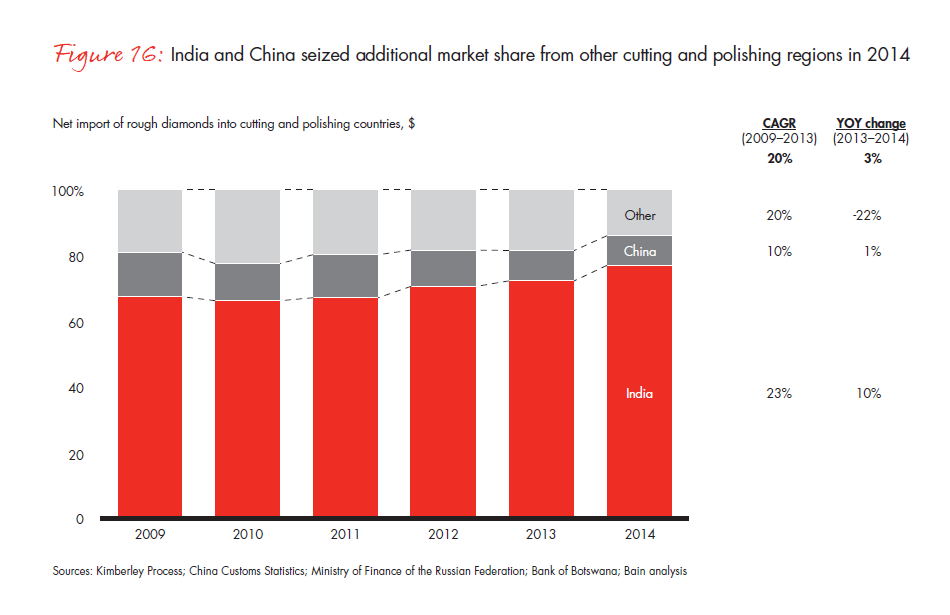
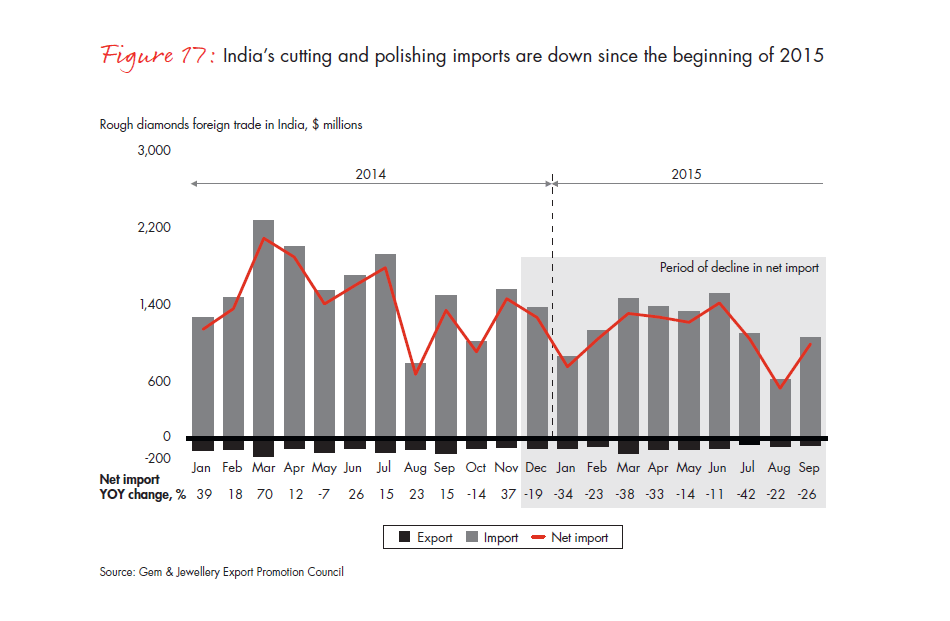
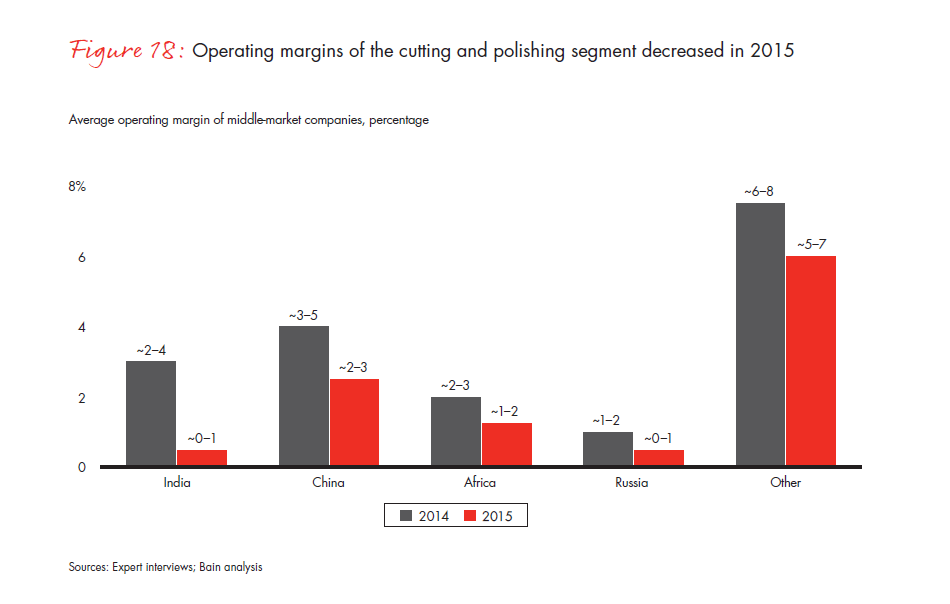
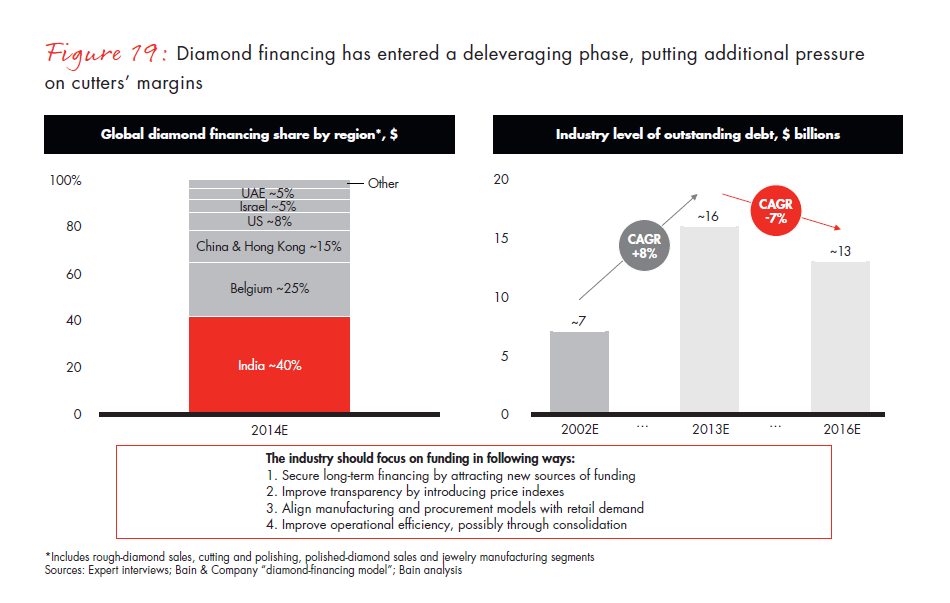
4. Diamond jewelry retailing
- The global personal luxury goods market, the traditional reference for the diamond jewelry market, grew by 4% in 2014. Slightly slower growth of about 2% is expected in 2015.
- Global diamond jewelry retail sales posted 4% growth in 2014, with the US as the main growth engine.
- In China, diamond jewelry sales grew 6% in 2014, but growth slowed in the second half of 2014 because of the economic slowdown and the continued curtailing of luxury spending.
- India recorded strong growth in diamond jewelry sales in 2014. Diamond jewelry demand in India is tied to the dynamics of gold. High gold prices in 2013 led to slowing purchases of gold jewelry as an investment and drove down overall demand for jewelry, leading to a significant rebound in 2014.
- Europe and Japan reported diamond jewelry sales declines of about 2% and 4%, respectively, in 2014.
- Looking at 2015 in the US, GDP growth is expected to approach 3%, with similar growth in personal disposable income, which historically closely correlates with diamond purchases. The US retail jewelry sector saw noticeable consolidation, with large chains gaining market share. Judging by the solid performance of major retail chains during the first half of 2015, full-year sales in the US are expected to maintain steady growth and offset weaker sales in China.
- The year 2015 is shaping up differently for Greater China. The largest Chinese diamond jewelry retailers reported an overall 9% year-over-year drop in sales in the first nine months of 2015. The Chinese stock market crash in June 2015 led to a decline in consumer confidence. Yuan depreciation led to an effective decrease in disposable income for Chinese consumers, which led in turn to lower sales of all luxury items. There was also a noticeable decline in tourist traffic in Hong Kong and Macao, with part of the tourist traffic moving to Europe and Japan as a result of depreciation of the euro and the yen.
- In India, diamond jewelry sales are expected to continue to grow in 2015, fundamental macroeconomic factors staying positive.
- In 2015, Europe and Japan are expected to post positive growth because the depreciated euro and yen are stimulating higher expenditures by visiting international tourists.
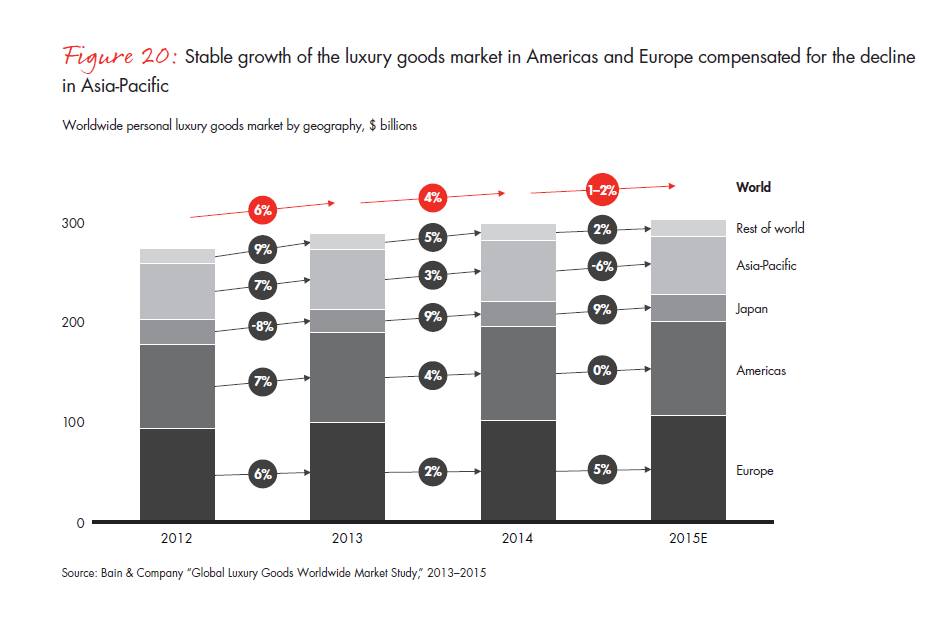
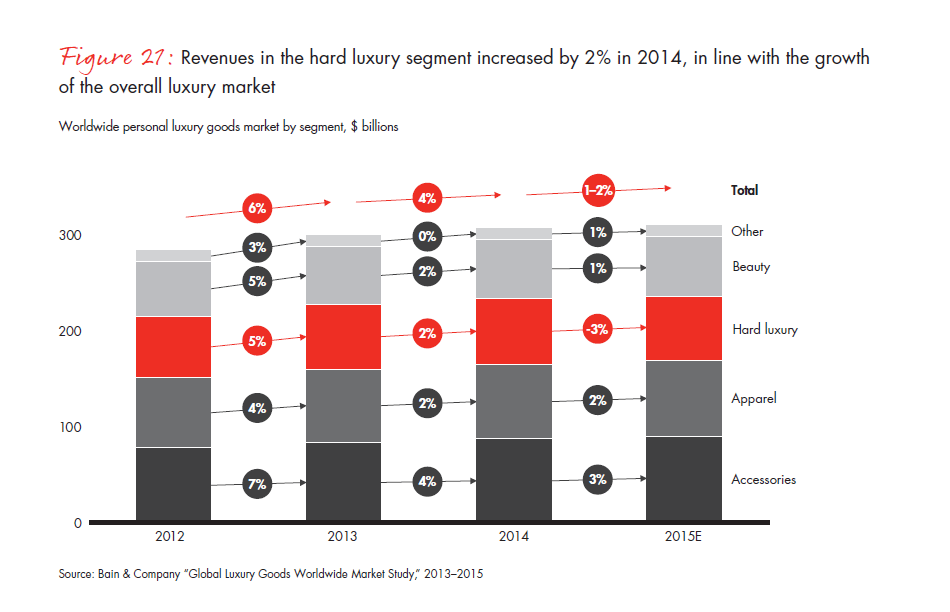
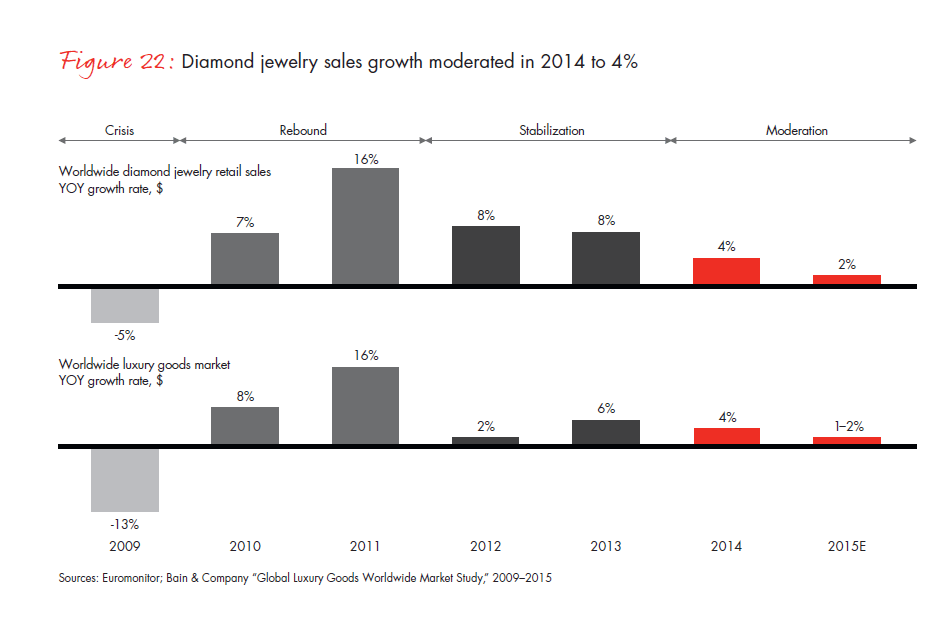
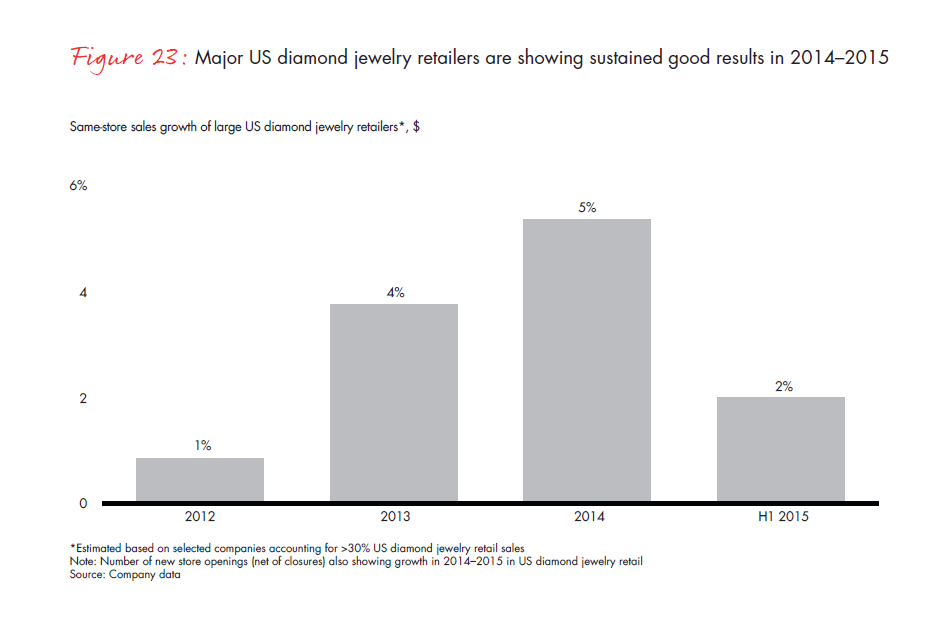
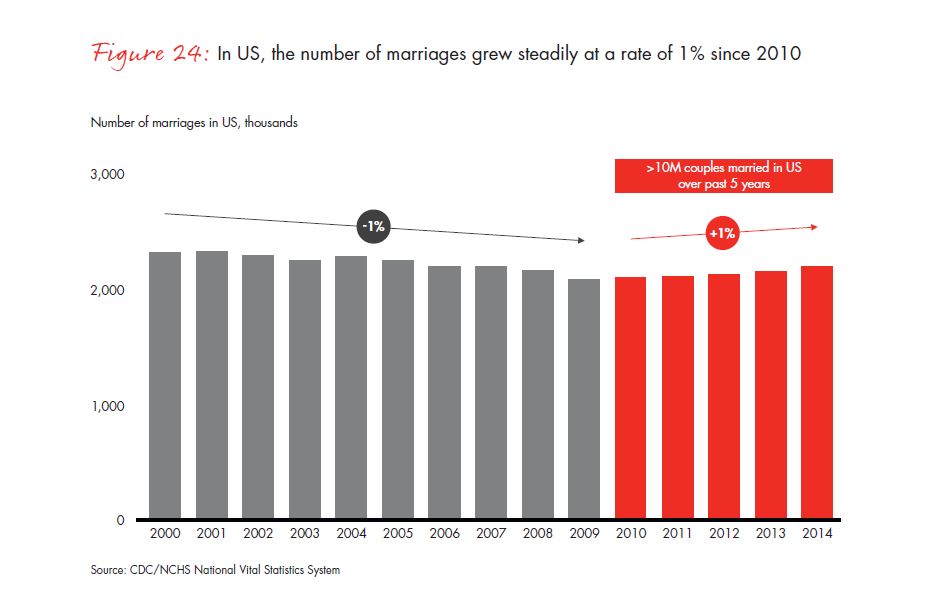
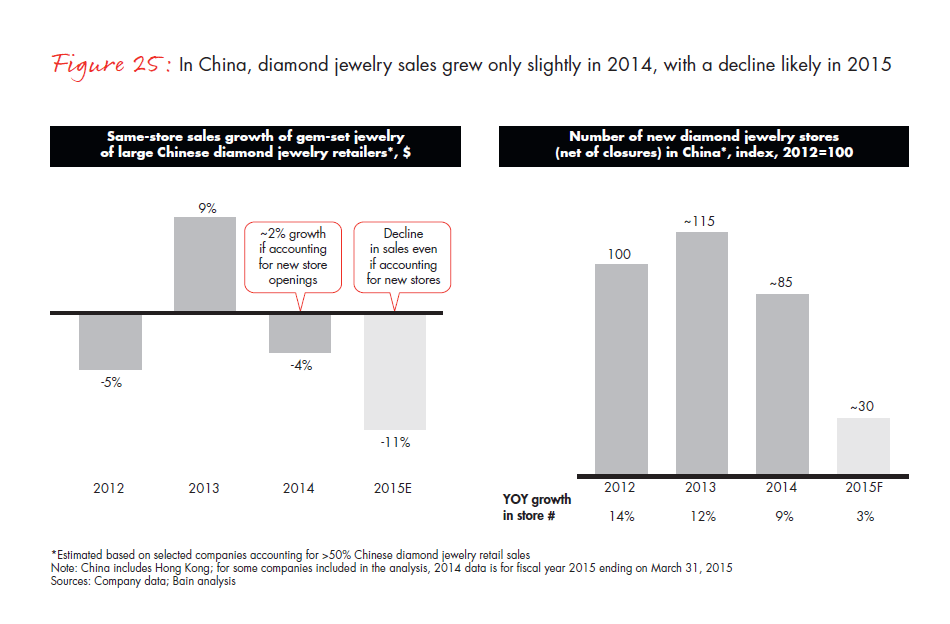
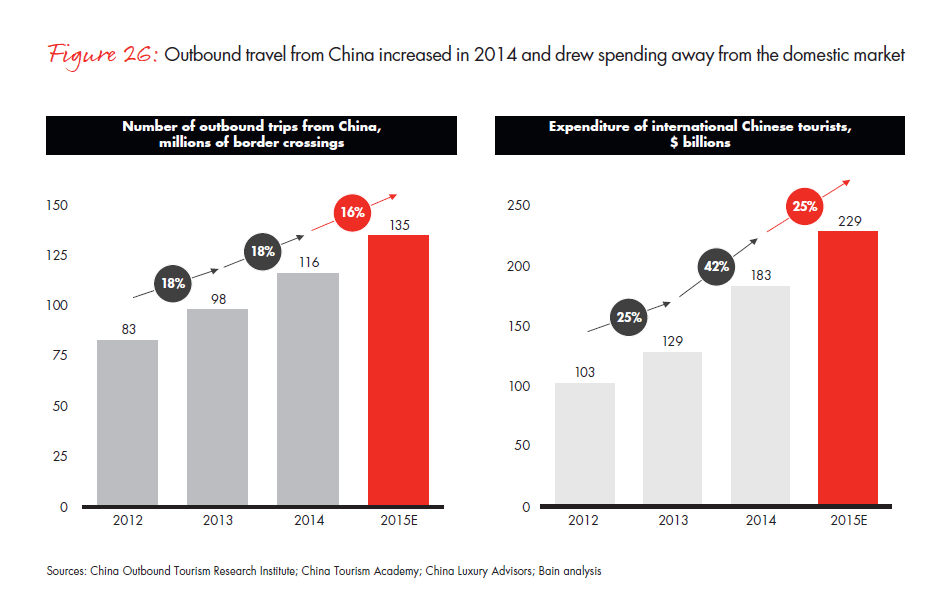
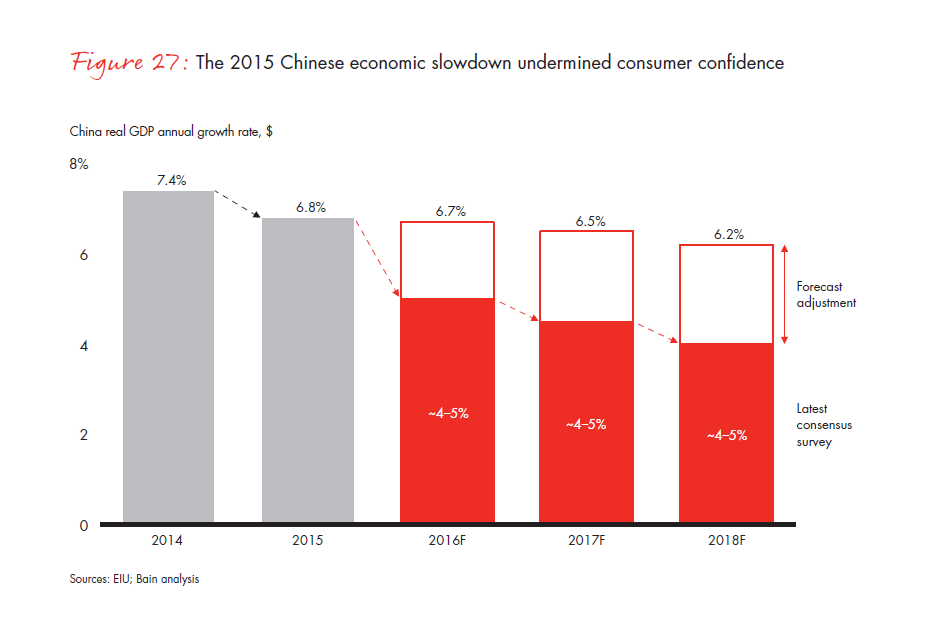
5. A brief overview of industry challenges
- One of the major short-term challenges in the diamond industry is unsustainable profitability erosion in the mid-market segment. Deteriorating profitability in the segment is symptomatic of its persistent problems and may eventually force structural changes. In light of the recent situation, it is imperative for cutters and polishers to improve operational efficiency, optimize business processes and redefine their overall business model. This may eventually result in the exit of the least efficient players and overall consolidation.
- Slowdown of consumer demand in 2014 and 2015 highlights a long-standing challenge for the industry to sustain long-term demand for diamonds. First, the industry may face changing consumer attitudes in Europe, Japan and the US, which account for about 50% of diamond jewelry sales. Bain studies show that luxury items are forfeiting their aspirational and status appeal in developed markets. Second, little is known of the diamond consumption patterns of a new generation of consumers. Third, the industry still struggles to boost investment demand for diamonds. In order to stimulate longer-term demand, industry players may need to collectively invest in generating qualitative and objective data as well as in generic marketing efforts in addition to brand campaigns aimed at sustaining diamond jewelry consumption preferences. The Diamond Producers Association was established in 2015 with a similar remit.
- Another challenge for the industry is the penetration of undisclosed synthetics that can undermine consumer confidence in the entire diamond category. This problem is more acute for smaller stones. Industry participants are actively addressing these concerns by tightening certification requirements; diffusing and adopting synthetic-diamond detection technologies, even for smaller diamonds; and tightening the legal and regulatory framework definitions of synthetic diamonds.
- The volume of diamond trade-ins remains relatively low. In the absence of a liquid secondary market, there is no reason to believe that diamond recycling will have a significant impact on the demand for polished diamonds in the near future. The estimated volume of recycled diamonds is between $1 billion and $1.2 billion, or 3% to 5% of the wholesale market for polished diamonds. However, as the supply of natural diamonds contracts in the long term and prices of polished diamonds continue to rise, the recycled-diamond channel may become more prominent.
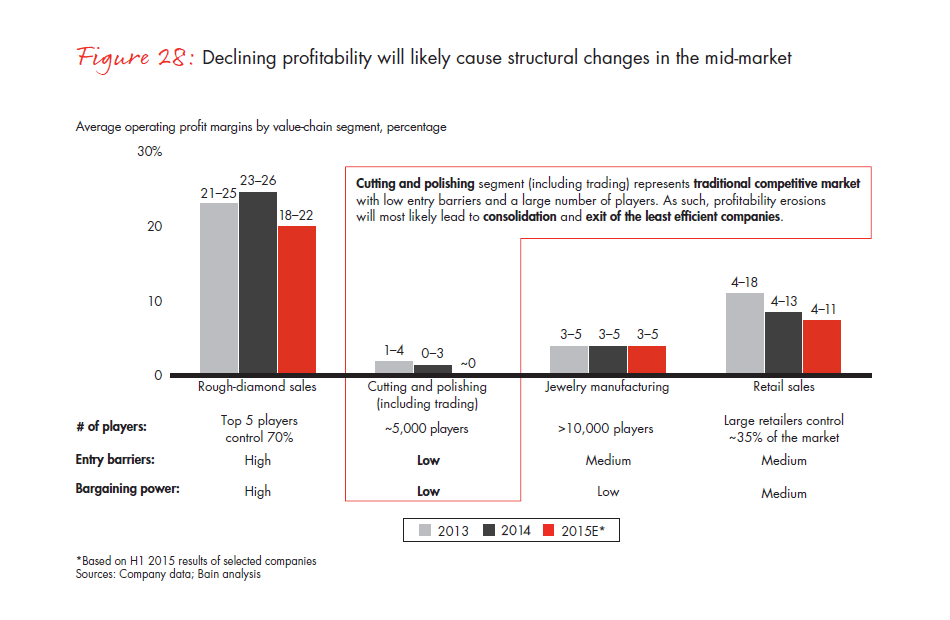
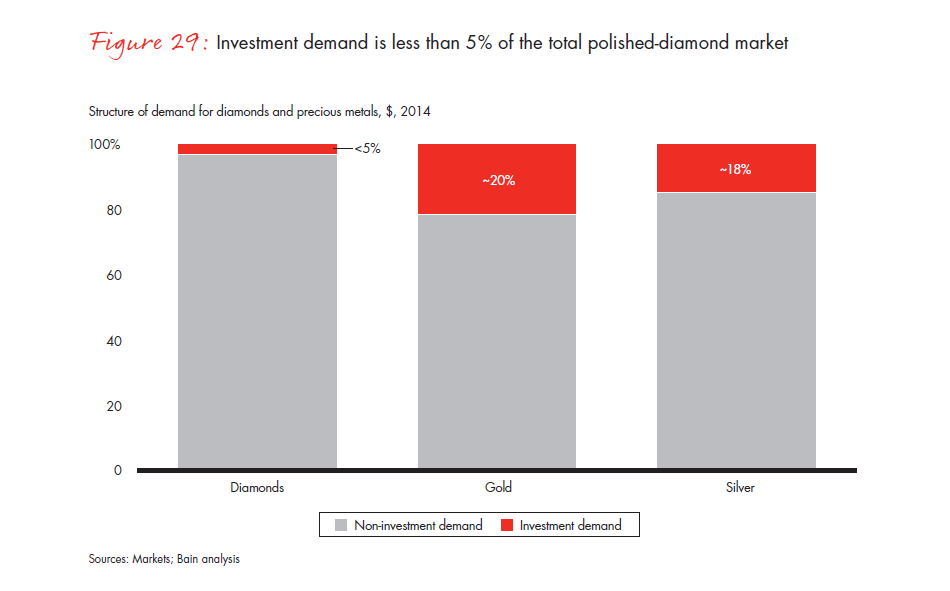
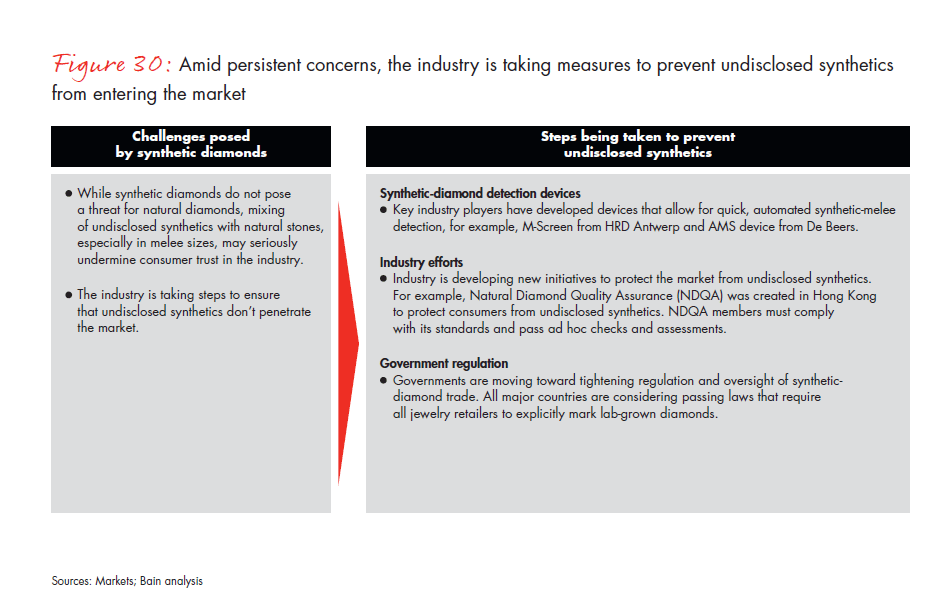
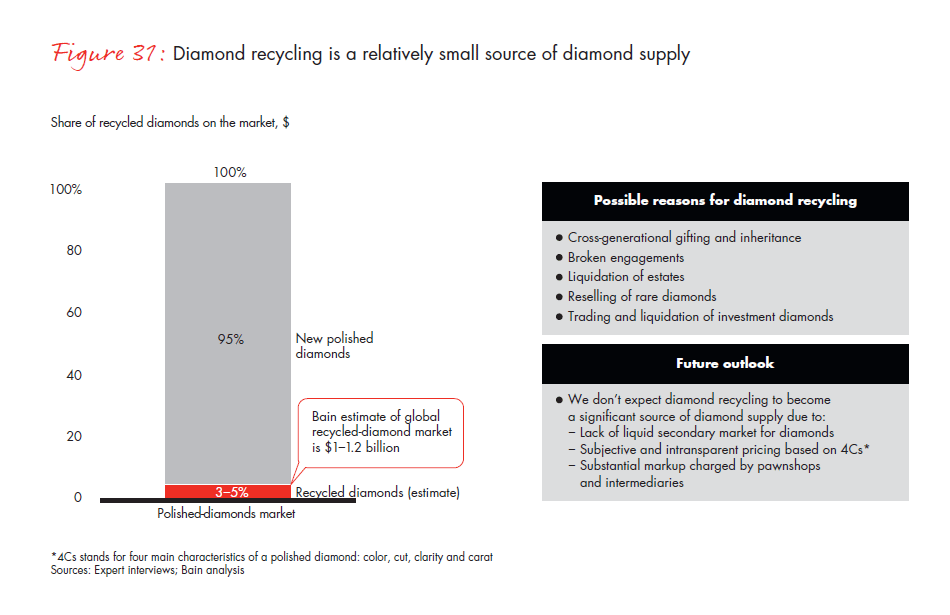
6. Supply-demand balance through 2030
- The world rough-diamond demand in the next 15 years is forecasted to grow at an average annual rate of about 3% to 4%, and the supply is projected to decline by 1% to 2%, causing the gap between supply and demand to widen starting in 2019. The forecast reflects fundamental supply and demand factors rather than short-term fluctuations or unforeseeable long-term macroeconomic shifts.
- China, India and the US are expected to continue being major diamond jewelry consumers, driving rough-diamond demand.
- In the US, disposable income growth of 1.5% to 2.5% per year should stimulate diamond consumption, with increases of 2.5% to 3.5% per year in the next 15 years in base scenario.
- In the long term, Chinese market growth is expected to slow down because of weaker economic growth and slowing expansion of the middle and upper classes. However, we expect the Chinese market to stay flat in 2016. Starting from 2017, we expect recovery and a gradual return to historical trajectory expected to lead to 4.5% to 5.5% annual growth until 2030 (down from about 7% in previous forecasts).
- We believe that India is transitioning from an emerging diamond market to a more mature market. Nevertheless, increasing urbanization, middle-class expansion and engagement ring penetration are expected to boost diamond demand by 8% to 9% per year in mid-term and then decelerate to 4% to 5% average annual growth (down from our previous projections of about 13%).
- Our forecast of the rough-diamond supply is based on the analysis of existing mines, publicly announced plans and anticipated production at every expected new mine. We foresee the global supply of rough declining on average by 1% to 2% per year from 2015 to 2030 because of the aging and depletion of existing mines and relatively little new supply coming online.
- Several risk factors, not included in the forecast, could affect the long-term diamond supply and demand balance: global macroeconomic shocks, geopolitical risks, changes in consumer preferences away from diamond jewelry, new sources of demand (such as investment demand), technical disruptions in supply and the impact of commodity prices on major producing countries and potential new sources of supply.
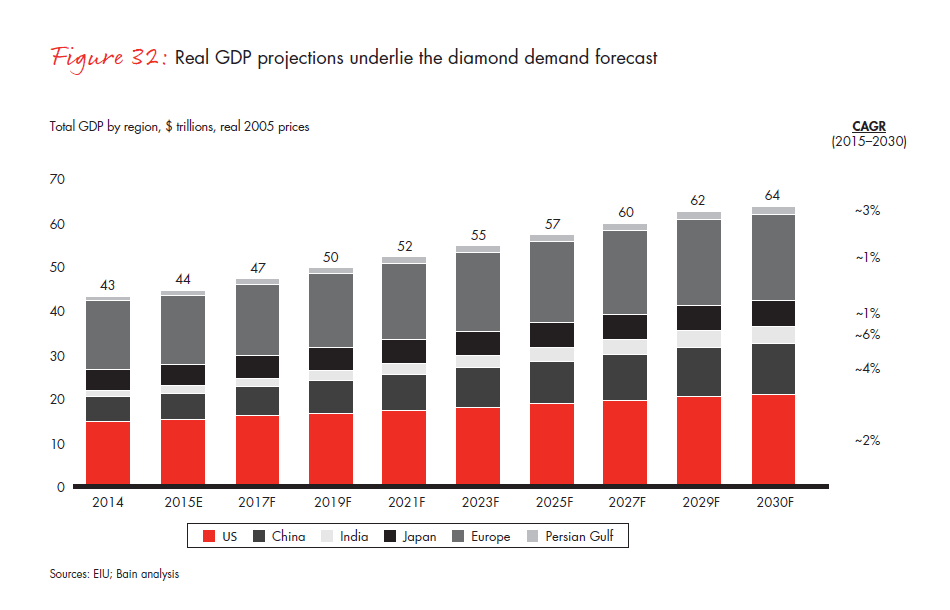
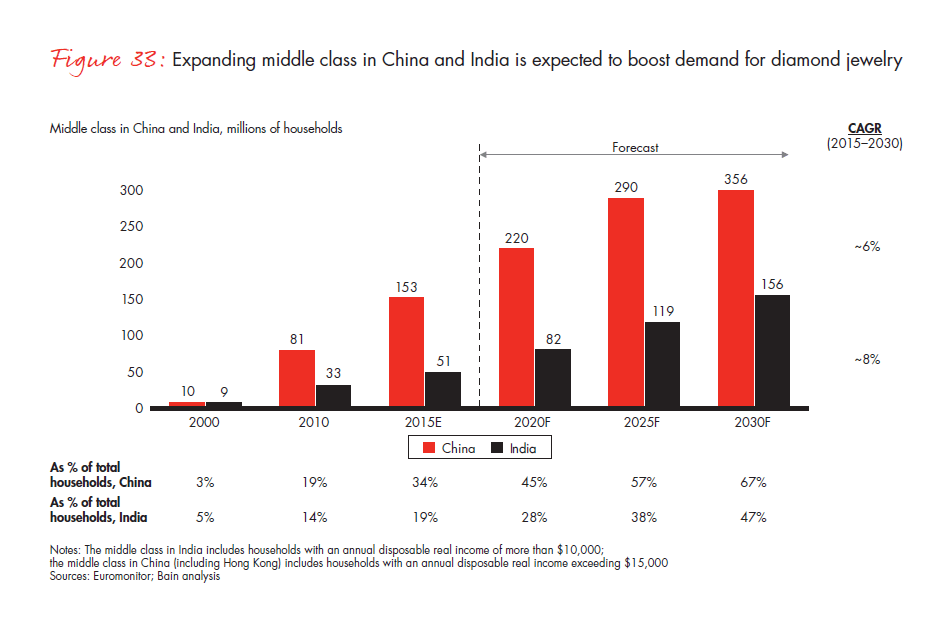
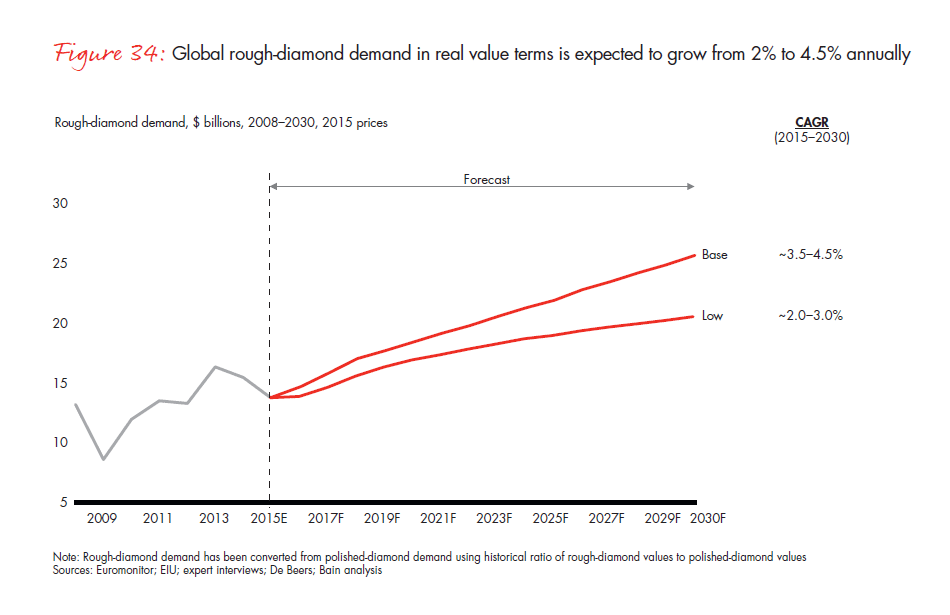
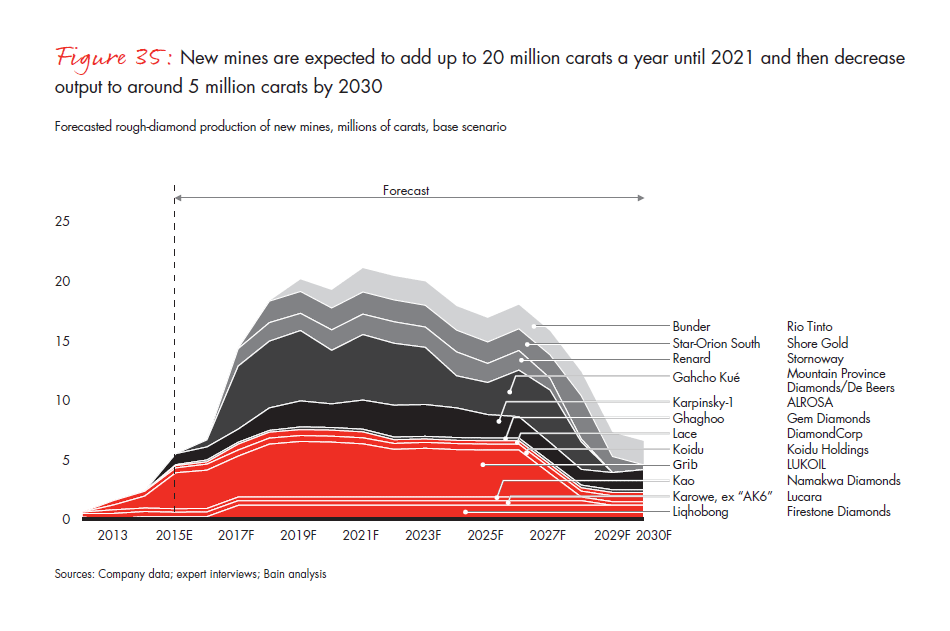
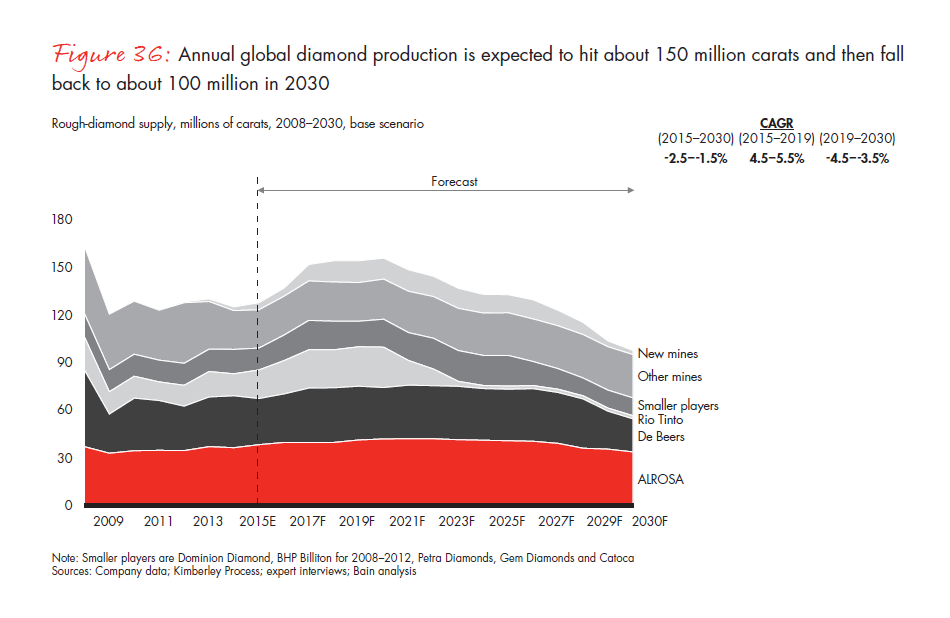
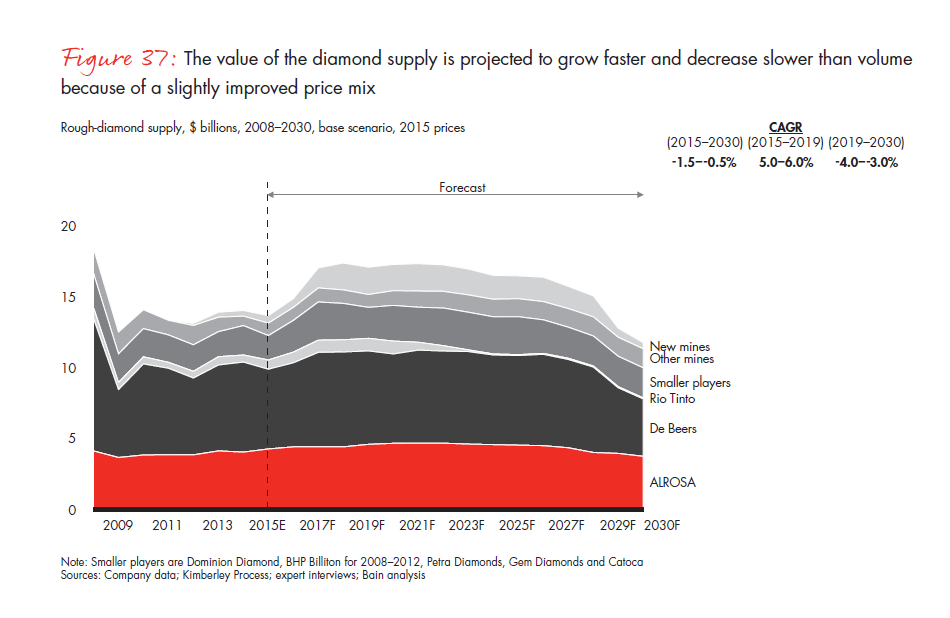
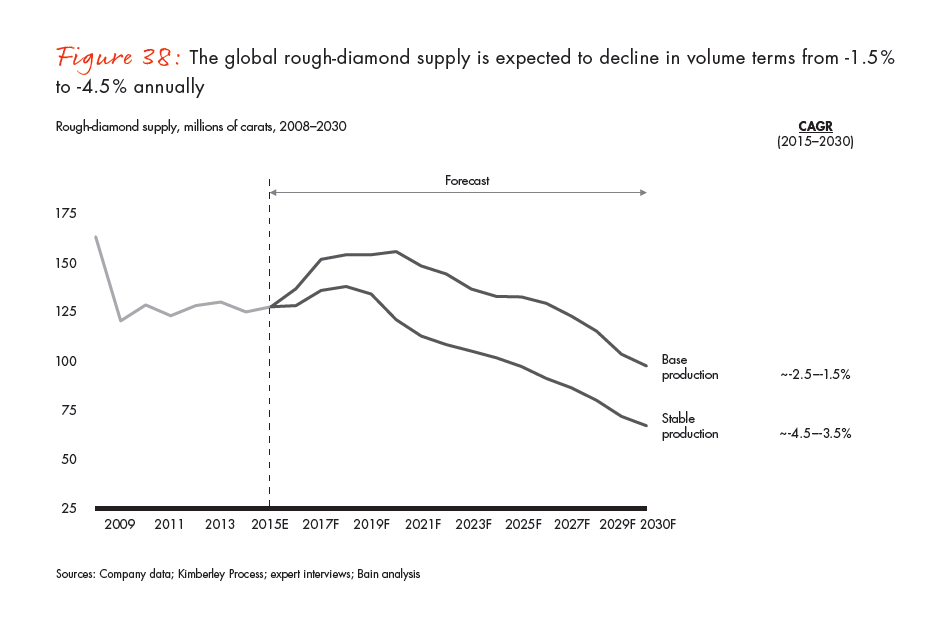
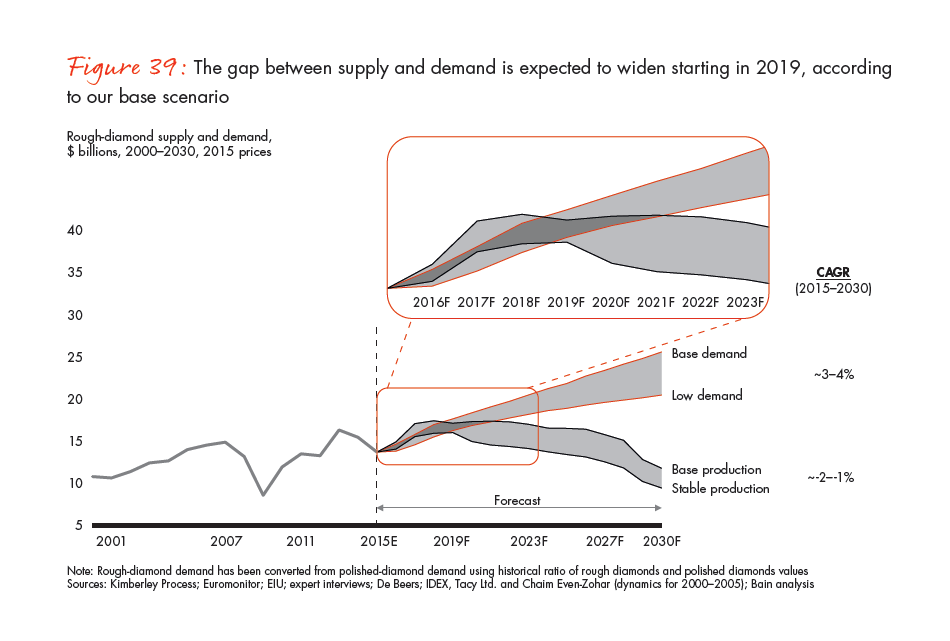
Key contacts for the report
This report was prepared by Olya Linde and Yury Spektorov, Partners from Bain & Company, and Aleksey Martynov, Principal from Bain & Company, together with Ari Epstein, Chief Executive Officer, AWDC, and Stephane Fischler, President, AWDC. The authors were supported by a global team, including Maksim Fedorenko, Yury Glazkov, Sophia Kravchenko, Anton Matalygin, Masha Shiroyan, and Bain’s Mining and Luxury Goods practices.






































